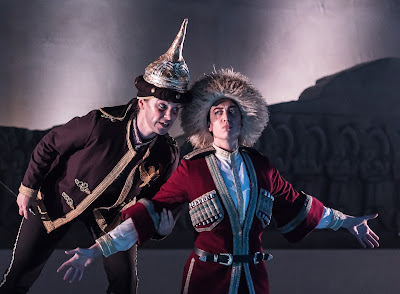 |
| Guildhall School - Radamisto - Anna Sideris, Dominick Felix - (c) Clive Barda |
Reviewed by Robert Hugill on Jun 07 2017
Star rating:
Imaginative re-invention of the first version of Handel's opera seria
Radamisto is one of the prime examples of the serious operas which Handel produced for his aristocratic patrons in London in the 1720s. The opera's dramaturgy remains problematic for modern productions and it was a pleasure to encounter John Ramster's imaginative production at the Guildhall School of Music and Drama's Milton Court Theatre on 7 June 2017. We saw the alternative cast with Anna Sideris as Polissena, Joanna Marie Skillett as Tigrane, Dominick Felix as Tiridate, Jake Muffett as Farasmene, Bianca Andrew as Radamisto, Jade Moffatt as Zenobia, and Elizabeth Skinner as Fraarte. Designs were by Louis Carver with lighting by Jake Wiltshire, and Victoria Newlyn was the movement director. Chad Matthias Kelly directed from the harpsichord.
 |
| Elizabeth Skinner, Jade Moffatt - (c) Clive Barda |
The opera takes two royal couples, and presents them with a series of obstacles in order for the hero to be able to show his essential nobility and moral fibre. The result is a highly complex plot, but to the original audience the logical flow of the plot would have been less important than the variety of individual situations in which the characters were place. Ramster's production took an unusual premise; a modern museum, displaying artifacts from ancient Black Sea kingdoms, is the venue for a tense meeting between two heads of state. As part of the official programme they watch a baroque opera, which is itself a museum exhibit with the characters using costumes, make-up and stylised gestures inspired by those of opera performances in the 1720s. As the opera develops the characters come more alive, the heads of state seem to get more involved in the production. Ramster, Carver and Newlyn used this combination of make-up, costume and gesture to help define the character of the villain, Tiridate (Dominick Felix) who is rather one dimensional in the opera.
For its first two acts the work operates at a very high level, Handel at his most imaginative, but the final act is problematic and culminates in a lieto fine which seems risible to us (Tiridate has a complete change of heart and becomes a good ruler). To make this happen, Ramster used his two heads of state as Dei ex machina, involving themselves in the production to prevent a tragic end.
 |
| Joanna Marie Skillett, Bianca Andrew - (c) Clive Barda |
Bianca Andrew as Radamisto took some time to develop, but then so does the character. Radamisto is not the most heroic of heroes, and only through a series of taxing situations does he show his mettle, and sense of moral purpose. Andrew similarly grew in stature, giving us some stylish singing on the way. As his supportive if fallible spouse, Zenobia, Jade Moffatt wonderfully drew our sympathies and impressed in her command of Zenobia's taxing arias.
Polissena gets to open the opera, and in striking music too. Anna Sideris did full justice to the drama, though her voice sometimes seemed to want to be singing 19th century opera. But Sideris was fully equal to the wonderfully dramatic moment when Polissena supports her tyrant husband, Tiridate, and refuses to countenance his death. Dominick Felix made a vivid Tiridate, entering with a will into the stylised gestures required of him, and having highly dramatic make-up to match. His arias are all vigorously vicious, but Felix sang them so vividly that we did not mind the lack of light and shade.
 |
| Anna Sideris - (c)Clive Barda |
Louis Carver is to be complemented not only on his imaginative costumes, with a good differentiation between characters and between opposing camps, but he also provided some nice solutions to having male characters sung by women. Credit music also go to Carver and the school's scenic department for the remarkable array of 'historic' artifacts displayed in the museum on stage.
John Ramster's production was a little too busy for my taste and he had a tendency to want to illustrate arias with the consequent danger of pulling focus. Thankfully the performances from the principals was so vivid that they were not upstaged. Whilst the production seem over-active, you sensed it was in the service of the drama and there was no suggestion of trying to keep the audience entertained during the long arias.
The theatre at Milton Court is relatively small and a horse shoe as Handel's theatre would have been. The intimacy favoured communication and enabled the singers to really project. The drawback was the relatively small pit, with an orchestra with just ten strings. Performances were crisply lively and matched the staged in projection, but there were also moments of uncertainly and unevenness. Chad Matthias Kelly kept the opera flowing (195 minutes including two 15 minute intervals) and Kelly, in both arias and recitatives, ensured the drama flowed with few awkward pauses. The recitative was not only creditably sung, but very engaging dramatically with a good sense of forward dramatic motion.
This was a welcome opportunity to hear Handel's April 1720 version of Radamisto in an engaging and vivid production. I do hope that the Guildhall School repeats the experiment, and I can think of a number of other baroque operas which would benefit from this treatment.



%20and%20kids.jpg)
.webp)


.jpg)



No comments:
Post a Comment